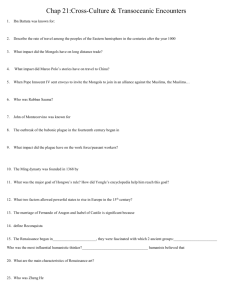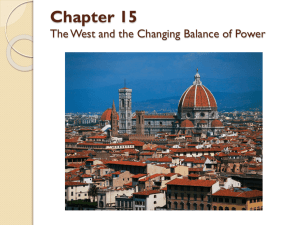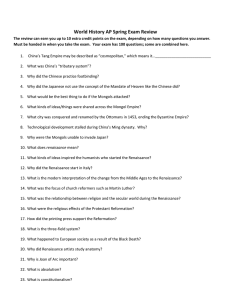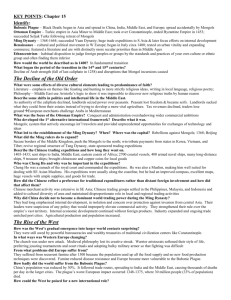The West and the Changing Balance of World Power
advertisement
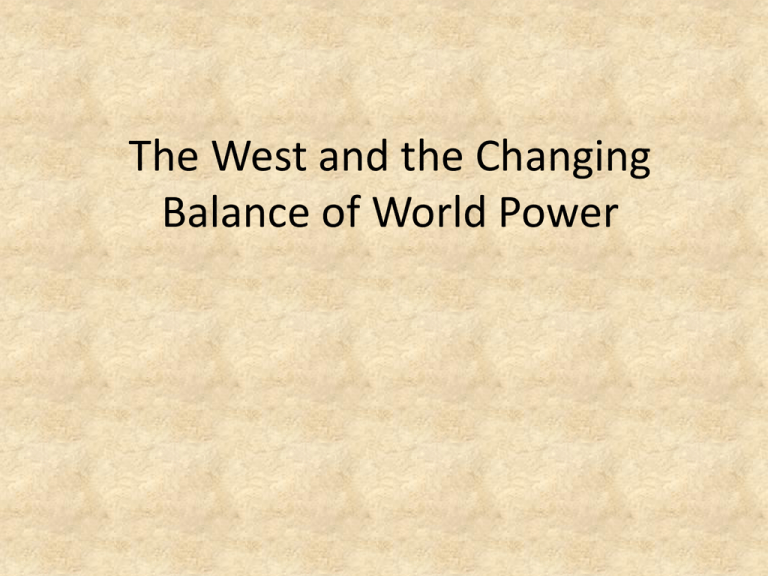
The West and the Changing Balance of World Power Introduction • Period of political transition • As Mongols conquered Arab Empires and the killed the Abbasid caliphate in 1258 new power opportunities were created. • China for a short time and Western Europe would be the ones to take advantage of this new power vacuum Introduction/ Compass • Many innovations and discoveries were not attributed properly to the people who invented or discovered them due to prejudices • For example, the compass was developed by the Chinese during the Tang dynasty. The Chinese introduced it to the Indians, Arabs, and then the Arabs to the Europeans. This technology allowed for greater navigation to lands for trade. Due to trade routes established by the Mongols, Europeans were introduced to many new products and ideas which would dramatically shape European culture like the compass Decline • 1200 Byzantine and Islamic empire/ caliphate dominated the Middle East • However by 1400 both the Byzantine and much of the Islamic empire had fallen • This created a power vacuum and gave a chance for others to move into positions of power. The Mongols originally took up this position, but quickly fell from power. The Chinese were the next to partially take up this vacuum, but decidedly turned their toward internal interest which allowed for a more weaken western Europe to expand! Social and Cultural Change: Middle East • New piety: Sufi movement • Literature: Focus on religious ideas • Philosophy: Rationalistic idea like those of Ibn Rushd came under attack in favor of religious devotion • Agriculture: As power of the caliph declined landlords seized control of peasant and turned them into serfs. Overall productivity declined and no new agriculture technologies were developed • Trade: Merchants lost some ground due to lower tax revenues, but still were very important in international trade Power Vacuum • Ottoman Empire did not unite all Arab lands nor was it the center of international trade • Mongols created a stable, profitable overland trade. When the Mongols declined suddenly overland trade was no longer safe and people began turning towards sea routes for trade purposes. Chinese Thrust and Withdrawal • 1368: rebellious Chinese drive out the Mongols • Ju Yuanzhang (the peasant leader) becomes the leader of the next dynasty, Ming. It ruled China until 1644! • By 1400 the Chinese had regained tribute payments (under the Tang) and started to sponsor state trading expeditions in the Indian Ocean –to Africa • Zhenghe led these expeditions. He was a eunuch who was castrated for his services to the royal court. He led 2700 coastal ships, 400 armed naval ships, 400 long distance ships, and 9 treasure ships. By 1433 the emperor had called and end to these expeditions. Confucian scholars who competed with Zhenghe for the attention of the emperor convinced the emperor it was not fiscal to spend such money on expeditions and that they should concentrate on internal affairs. The Chinese did not need foreign products…they had plenty of internal products! (Textile and porcelain ) • Think what would have happened had the Chinese not stopped they surly would have easily conquered European vessels! A map of Ming dynasty China, showing the surrounding kingdoms and peoples. Chinese Withdrawal • This shift in Chinese foreign policy would allow way for a less organized civilization to increase their international powers • China retreated and the Arab powers now were eclipsed…giving way to the powers of western Europe. Rise of the West • Church was now under attack • Bubonic Plague spread throughout Europe decimating the population. The plague most likely was spread via Mongols to Asia, the Middle East, and Europe. Around 30 million Europeans died from the plague • 1348-1378 Plague hit hardest in Europe • 1300’s famines due to food shortages! Sources of Dynamism: Medieval Vitality • Feudal monarchies strengthened in Europe and their powers became more consolidated and centralized • Innovations occurred in military organizationstate soldiers paid directly by governments • Muslims of Spain were driven out thanks to the Reconquista • Cities and towns grew as well as commerce • Technology improved Imitation and International Problems • Mongol empire and their trade routes established new access to Asian knowledge like the compass, printing, and gunpowder • Trade problems between Europe and Asia: Europe had an uneven exchange with Asia. They traded wool, tin, cooper, honey, and salt for luxury goods of spices (cinnamon and nutmeg), silks, sugar, perfumes, and jewels. Of course the Europeans had to supplement their exchange with gold. Soon the economies of Europe were drained of their gold and they required a new source in order to keep getting the luxury good from Asia • The Europeans also feared the Muslims and therefore were seeking alternative trade routes to Asia to by pass the Muslims and unstable lands of the Silk Roads to get their Asian luxury goods • • • • • Secular Directions in the Italian Renaissance Human Values and Renaissance culture Renaissance –rebirth of culture and scholarship in Europe. Focus of activity within aristocracy. 1350-1550 Used classical models for inspiration: Greece and Rome Started in Italy (geography, trade, root of Roman Empire) Franceso Petrarch-father of humanism Innovations flourished and exploration and conquest reflected the glory and nature of man Renaissance • Rebirth • Scholars use the term Renaissance to describe the cultural achievements of the 14th –16th centuries • Italy led the way due to the commercial revival of the area that started in the 11th centuryCrusades • Italy distinguished from the rest of Europe by its urbanization • Italy had more major and minor cities than anywhere else: geography key • Amounts of disposable wealth went up after plague-luxury items increased • Life was hard for the young and especially the poor: children sent to work: boys at age of 10 became apprentices and girls domestic servants • Renaissance Art The art of the • Art was also a product of Renaissance owed much the educational system: to the social system in principles of the craft and which artists lived guild • Wealth of cities • Renaissance artists had permitted for public to solve problem of works of art, which was perspective and threecommissioned by dimensionality. They corporate sources to returned to classical show their power. Later ideas, realism, nude it was used on individual figures, and expression in level to show rich (newly) the face • Disposable wealth (non • The artist was considered critical personal funds) a free intellectual worker led to interest in and was respected and portraiture rewarded. Crucifixion 1335 Example of Middle Ages Art Museo ThyssenBornemisza, Madrid The Engagement of Virgin Mary) Example of Renaissance Art Raphael 1504 Great Renaissance Artists Michelangelo (sculpture) Leonardo da Vinci (painting) Sandro Botticeli (painting) Brunelleschi (architecture) Donatello (sculpture) Masaccio (painting) Raphael (painting) David, Sistine Chapel, Pieta Mona Lisa, Last Supper Birth of Venus, Spring Florence Cathedral Judith Slaying Holofernes Expulsion of Adam and Eve The Engagement of Virgin Mary) Works • Leon Battista Alberti (1404-1474)- On the Family: classic study of new urban values-thrift and prudence • Baldesar Castiglione (1478-1529)-The Courtier: an etiquette book that prescribed every detail of the education necessary for the ideal state servant • Francesco Petrarch (13041374): important figure in literary humanism • Niccolo Machiavelli (1469-1527): The Prince: blueprint to realistic, modern power politics. Explores how a ruler should gain, maintain, and increase power. It is better to be feared than loved. A ruler should also be concerned with the way things are NOW not the way things ought to be. Machiavellian: entered the language as a synonym for politically devious, corrupt, and crafty. Intellectual Hallmarks• • Individualism: stressed personality, uniqueness, genius, and full development of one’s capabilities and talents. Leon Battista Alberti (1404-1474) “Men can do all things if they will” • Humanism: revival of antiquity (Greece/Rome). Humanists studied the Latin classics to learn what they reveal about human nature. Humanism emphasized human beings, their achievements, interests, and capabilities. Humanists placed importance on grammar, rhetoric, moral philosophy, and history. Focused on 2 major philosophers-Plato and Aristotle. Philology or the study of the origins of words was central to a humanist like Lorenzo Valla who proved the Donation of Constantine was a forgery • Secularism: involves a basic concern with the material world instead of with the eternal world of the spirit Iberian Spirit • Reconquista-pushed Muslims and Jews back. Jewish converters to Christianity: conversos • 1469 Castile and Aragon united =Spain with marriage of Ferdinand and Isabella • Reconquista –religious and military unification of Spain • Religion and spreading the message of the Catholic Church was soon sponsored by Spain to expand to other lands Early Explorations • 1200 –Vivaldis (Italian) brothers sailed passed the Straits of Gibraltar seeking a new route to Asia, but they were never heard from again! • Until the 1430’s technological barriers kept Europe from exploring and navigation far beyond the Mediterranean. Soon Chinese technologies via Arab merchants (compass and astrolabe) and better ships allowed for voyages. • 1498 Vasco da Gama of Portugal was the first European to reach the Indies by sea Colonial Patterns • Spanish and Portuguese began to take advantage of new lands they discovered. Prince Henry of Portugal known as Henry the Navigator sponsored many voyages of Portugal prior to his death in 1460. He also took advantage of these lands economically, sending colonists to them as well as the message of course of Christianity. The colonists would set up large agricultural estates and grow cash crops that would be sold back in European markets. Cash crops like sugar were grown. Europeans also grew tobacco and cotton. Slaves from Africa were used to farm these agricultural products. • These ventures were successful enough to launch more voyages beyond the Atlantic islands Americas • In the 1400 the Aztec and Inca empires ran into problems. The Aztec empire created many enemies with their tribute, need for slaves, and need for human sacrifice while the Incas had a problem in regards to claims to the position of emperor and had broken out into a civil war! • When the Spanish conquistadors landed in the 1500’s, the Aztecs and Incas were divided and already weakened. The Spanish just arrived at an opportune time Expansion, Migration, and Conquest in Polynesia • 7th-1400’s developed in relative isolation like the Americas • Postclassical era known for expansion, migration, and conquest • Spread to Society Islands, Tahiti, Samoa, and Fiji!!! I LOVE FIJI!!! Fiji regional kingdoms and tribes would fight each other…cannibals • reached the uninhabited Hawaiian islands in 7th century by way of war canoes! Remained in contact with Society Islands and was cut off until European explores arrived in 1778 • Hawaii organized into regional kingdoms and were highly warlike, hierarchy established, and had a complex culture living with Neolithic technologies! Isolated Achievements by Maori • New Zealand. The Polynesians migrated to New Zealand as early as the 8th century. They lived primary in the northern island of New Zealand. The people were called the Maori. • New Zealand is colder so the Maori had to adapt to this environment. They created great art and were organized into tribes with military and priests who held power. The tribe also included slaves who were POW’s and their descendants. Their traditional dance includes eye bulging to scare off enemies! • They were totally isolated until the 18th century. • Some Polynesians such as the Maori were totally isolated. Adding Up to Changes • Complex coincidences led to changes • Independent developments in Americas, China, technological developments by Asia, improvement of ships, and goals of leaders like Prince Henry the Navigator. • Sub-Saharan Africa had continuity. Mali fell, but Songhay arose to power from 1464-1591 • Decline of Arabs meant the decline of African trade networks. They also were kept from major advantage of Mongol trade networks 1450 and the World • Postclassical period full of continuities and changes. Changes came in empires that contacted other empires like Muslims and Mongols. • Connection between Asia and Europe • China active role for a short time in Indian Ocean trade • Shift from overland trade to sea routes • Continuity: interest in trade and contacts. Value of Afro-Eurasian contacts Works Cited http://pvs.kcc.hawaii.edu/polynesia.html http://depts.washington.edu/chinaciv/1xarming.htm
